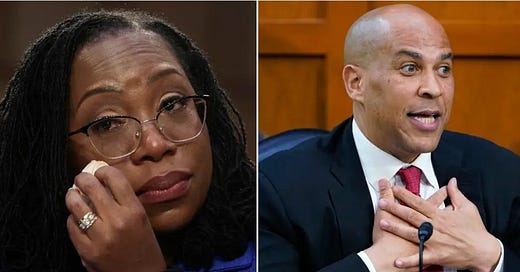
THE SUPREME COURT IS EVERYTHING, PART I
That quote is from Senator Cory Booker who also said “I won’t let them steal my joy.” It’s hard to describe how moving his statement—and Judge Jackson’s response to it—was. I confess, though, that I haven’t been able to watch much of the confirmation hearings of Judge Ketanji Brown Jackson. Time constraints aside, Lindsay Graham’s performance alone almost made my head explode. A line of questioning about the “faith” of any nominee for any position should have been shut down immediately. When Ted Cruz, Marsha Blackburn, Tom Cotton, and Josh Hawley jumped in it got much worse.
The difference in tone and tenor of the questions asked by Democratic and Republican Senators reminded me yet again of a mystery I have yet to solve: What about the Republican’s sneering, whining, contemptuousness and fact-free condescension appeals to anybody? Is it simply their white supremacy? But that, too, is a conversation for another time.
What is mostly on my mind at the moment is the institution of the Supreme Court itself. What kind of body is it now? What role has it served historically? What could it be if more judges like the eminently qualified Ketanji Brown Jackson were a justice? Why has it been so difficult to get a majority of justices who understand the Court’s role, and who represent the majority of Americans?
Ahead of the 2022 and 2024 elections, those of us who care about saving this country from autocracy (at best) and fascism (at worst) must be one-issue voters: We must cast our vote for democracy—which means voting for Democrats across the board at all levels of government. When we win, we need to agree that the next issue we must focus on is the Supreme Court. The right has understood for a long time that the courts and the Court are the places where they can most effectively get their agenda enacted. The left, for reasons I don’t quite understand, does not seem to understand this. Maybe it has to do with the fact that the Democratic coalition is incredibly diverse while many on the right are one issue voters—anti-choice, anti-immigration, Second Amendment fanatics—and they understand that SCOTUS is the final arbiter of those issues.
Leaders in the Democratic Party need to help their constituents understand that the Supreme Court makes decisions about everything we find most important including climate change, dark money in politics (looking at you Citizens’ United), gun safety, the right of people to have abortions, the equal status of women, the rights of trans children and adults, marriage equality, and practically everything else that would enable America to become a more perfect union.
JUST BECAUSE A MAJORITY ON THE SUPREME COURT SAYS IT’S CONSTITUTIONAL DOESN’T MEAN IT IS
A string of antidemocratic Supreme Court decisions started before the Civil War with the Court’s ruling in the 1857 Dred Scott case. Scott, who had been born into slavery, was brought to Illinois, a free state, by his enslaver. When they returned to Missouri, a slave state, Scott sued for his freedom, claiming that he had been free in Illinois and should be allowed to remain free. When state and federal courts ruled against him, he appealed to the Supreme Court.
The opinion, written by Chief Justice Roger Taney, concluded that “[Black people] are not included, and were not intended to be included, under the word ‘citizens’ in the Constitution, and can therefore claim none of the rights and privileges which that instrument provides for.” He went even further, claiming that individual states could not grant Blacks state citizenship, because “[the negro] had no rights which the white man was bound to respect; and that the negro might justly and lawfully be reduced to slavery for his benefit.”
Unbelievably, Taney and the other six justices who sided with him thought that their decision would definitively settle the question of slavery and calm the tensions that had been growing between North and South for years. This couldn’t have been further from the truth, and the Scott decision brought the nation several steps closer to civil war. We ’ve learned over the last two and a half centuries that, although rights can be granted by Congress, the Supreme Court doesn’t necessarily guarantee them.
In the decades following the Civil War, the court demonstrated this most glaringly in several decisions that severely compromised the seminal advances achieved during Reconstruction with the passage of the Thirteenth, Fourteenth, and Fifteenth Amendments. In the years 1865 to 1878, in fact, the Supreme Court embarked on one of the greatest assaults on democracy in the history of this country.
From the nation’s founding until 1865, the Supreme Court had struck down just two congressional acts as unconstitutional. Between 1865 andn1876, the court did so thirteen times, including its decision on the Enforcement Acts of 1871 (of which the Ku Klux Klan Act was the third), which came five years later in United States v. Cruikshank. The case arose after as many as 280 Blacks were massacred, some after having surrendered, in the aftermath of a gubernatorial election in Louisiana in which both sides had declared victory. Although some of the white perpetrators were indicted and set to face federal charges, as provided for by the Enforcement Act, when the case got to the Supreme Court, a majority ruled that the charges against individuals who were not state actors were unconstitutional because the federal charges infringed upon states’ rights.
In other words, the federal government had no power to prosecute individuals who committed terrorist acts even if the state refused to do so. The defendants’ convictions were overturned, and the decision seriously undermined the equal-protection clause of the Fourteenth Amendment (“nor shall any State deprive any person of life, liberty, or property, without due process of law; nor deny to any person within its jurisdiction the equal protection of laws”), as well as the safety, suffrage, and freedom of Southern Blacks.
The court continued to strike blows against the Fourteenth Amendment when, in 1896, it issued its decision in Plessy v. Ferguson which upheld the constitutionality of segregation as long as segregated facilities were “equal,” proved crushing for the prospects of Black Americans. The case had been brought by Homer Plessy, who had been charged with riding in a whites-only train car—even though he was seven-eighths white. The 7–1 majority opinion held that the Fourteenth Amendment “could not have been intended to abolish distinctions based upon color, or to enforce social, as distinguished from political equality, or a commingling of the two races upon terms unsatisfactory to either.”
Only seven years later, the court heard Giles v. Harris, the case of Jackson Giles, a courageous Black man from Alabama who, after voting for thirty years, was prohibited from doing so in 1901 because of regressive changes to voting rights enshrined in the state’s new constitution that disproportionately affected Black Americans. Giles claimed that the new laws violated his Fifteenth Amendment rights. The court doesn’t seem to have addressed that question directly but instead ruled that, because the plaintiffs wanted to be registered to vote despite claiming the state ’s new voting restrictions were unconstitutional, registering them would not remedy the situation. So, the plaintiffs were disenfranchised and the unconstitutional state law was left to stand.
In Milliken v. Bradley, a 1974 case about school segregation in Detroit public schools, the plaintiffs argued that, because neighborhoods had been racially segregated as the direct result of government policy, segregating schools was unconstitutional. Despite the fact that school segregation was indeed the direct result of decades of housing segregation mandated by local, state, and federal government agencies and that plaintiffs had presented evidence proving this, the court ruled against them. The majority opinion, written by Chief Justice Warren Burger, claimed that as long as school districts had no racist intent in drawing district lines, there was no obligation for them to desegregate. Ignoring evidence that had been presented to the court, Burger continued, “No record has been made in this case showing that the racial composition of the Detroit school population or that residential patterns within Detroit and in the surrounding areas were in any significant measure caused by governmental activity.” This conclusion was absurd on its face.
In his dissent, Justice Thurgood Marshall wrote, “Our Nation, I fear, will be ill served by the Court’s refusal to remedy separate and unequal education, for unless our children begin to learn together, there is little hope our people will ever learn to live together.” His concerns proved prescient when, after the ruling, the schools and neighborhoods of Detroit became even more segregated.
Over thirty years later, Chief Justice John Roberts would join in a majority opinion that echoed Chief Justice Burger’s, claiming that school districts in Louisville and Seattle could not use students’ race as a metric in integration plans. Roberts wrote that segregated neighborhoods may be the result of “societal discrimination,” but the discrimination itself was “not traceable to [government’s] own actions.” “This misrepresentation of our racial history,” Rothstein concludes, “indeed this willful blindness, became the consensus view of American jurisprudence.”
Aaron Belkin, the director of the group Take Back the Court, said, “There’s growing recognition that the Supreme Court poses a danger to the health and well-being of the nation and even to democracy itself. A White House judicial reform commission has a historic opportunity to explain the gravity of the threat and to help contain it by urging Congress to add seats, which is the only way to restore balance to the court.”
As has so often been the case, the Supreme Court’s role in erring on the side of undermining the Constitution, failing to protect the vulnerable, and empowering anti-democratic legislation was in full force with the Anti–Drug Abuse Act. In a series of rulings which devastated protections afforded by the Fourth Amendment against unreasonable search and seizure, the purpose of the Constitution’s original text was ignored(as the Court’s so-called originalists often do). In addition, the power of the police to engage in such searches was expanded past the point of absurdity, until there was little need for them to show probable cause. It all seems designed essentially to criminalize Blackness which was a major goal of the Black Codes during Reconstruction and Jim Crow laws over a hundred and fifty years ago.
So here we are in 2022. Republicans on the Judiciary Committee did their best to paint Judge Jackson as a pro-crime, pro-pedophile Black woman. They asked her to take responsibility for the views of Black people to whom she has no connection. They had the gall to interrupt her time after time after time, this woman who is more accomplished, more worthy, more intelligent, and more American than these mediocre white men who have done nothing but fail upwards for their entire lives ever could be.
Republican Senators flew the flag of white nationalism openly, unabashedly. and they need to be punished for it.














Thank you Mary for covering this issue so thoroughly. I have no respect for the current Supreme Court. I have not watched the hearings; not because of time constraints but because my blood pressure rises to unhealthy levels every time a GOP idiot starts spewing their racist BS. I did see Bookers’ speech on the news and it brought tears to my eyes. It should have brought shame to those GOP senators but they’re all beyond redemption.
This is Mary Trump at her best!